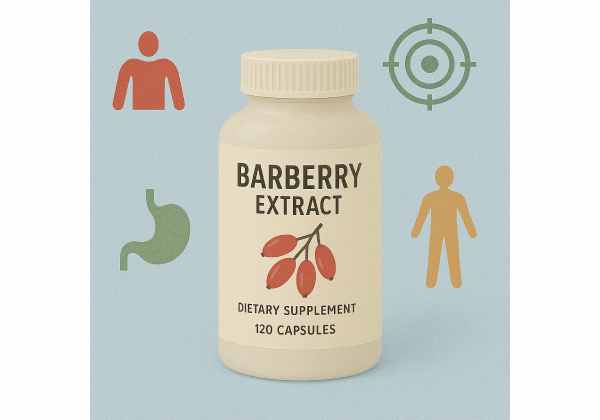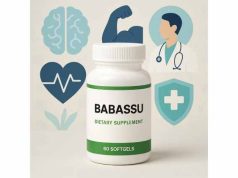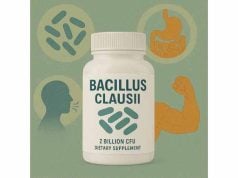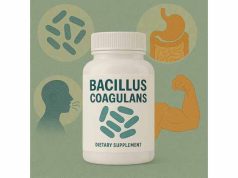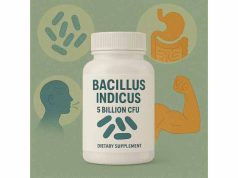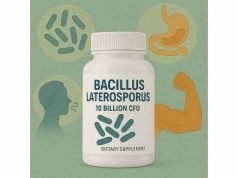Can a bright red berry really help balance blood sugar, support gut health, and protect your heart? Barberry extract—derived from the berries, roots, and bark of the Berberis plant—has gained global attention for its unique blend of powerful alkaloids, especially berberine. Barberry extract stands out for its wide-ranging evidence-based benefits: supporting metabolic health, improving digestion, fighting inflammation, and offering potent antioxidant effects. In this comprehensive guide, we’ll break down what barberry extract is, how it works in the body, its most researched benefits and uses, proper dosage and timing, potential side effects, and frequently asked questions. By the end, you’ll have a clear, science-based understanding to help you decide if barberry extract is right for your health needs.
Key Takeaways
- Barberry extract is rich in berberine, a natural compound with broad metabolic, antimicrobial, and anti-inflammatory effects.
- Common uses include supporting blood sugar regulation, cholesterol management, digestive health, and immune support.
- Generally safe for most adults when used appropriately, but can interact with certain medications and may cause mild digestive side effects.
- Typical dosages vary based on formulation and health goals; consult a professional for personalized advice.
- Barberry extract is available as capsules, tinctures, powders, and teas, with quality and berberine content varying by product.
Table of Contents
- Barberry Extract Overview: What It Is and What It Does
- The Science of Barberry Extract: Mechanism of Action and Bioactive Compounds
- Evidence-Based Benefits and Uses of Barberry Extract
- Barberry Extract Safety, Tolerability, and Potential Side Effects
- Dosage, Usage, and Optimal Administration of Barberry Extract
- Barberry Extract Frequently Asked Questions (FAQ)
Barberry Extract Overview: What It Is and What It Does
Barberry extract is a potent natural supplement sourced from the roots, bark, and vibrant berries of the Berberis genus—a family of hardy shrubs found across Europe, Asia, North Africa, and North America. The best-known species, Berberis vulgaris (European barberry), has been prized for centuries in traditional Persian, Ayurvedic, and Chinese medicine for its distinctive tart flavor and its broad therapeutic properties.
Botanical Profile and Appearance
Barberry shrubs produce small, oblong red berries and spiny, greenish-yellow stems. All parts of the plant contain valuable alkaloids, but the roots and bark are especially rich in berberine—the main bioactive compound responsible for many of the plant’s therapeutic effects.
Traditional and Modern Uses
Historically, barberry extract was used to treat:
- Digestive complaints, including diarrhea and indigestion
- Liver and gallbladder conditions
- Skin infections and wound healing
- Fever, sore throat, and urinary tract issues
Today, modern research has confirmed many of these uses, particularly those relating to metabolic health, inflammation, and microbial balance. Barberry extract is now sold worldwide as a dietary supplement for:
- Blood sugar support (especially in insulin resistance or type 2 diabetes)
- Lowering cholesterol and triglyceride levels
- Enhancing digestion and gut health
- Supporting immune function and fighting certain infections
Barberry vs. Berberine
It’s important to note that “barberry extract” and “berberine” are not the same, though they’re closely related. Berberine is one of several alkaloids found in barberry and is responsible for most of its well-studied health effects. However, whole barberry extract contains other beneficial compounds—like oxyacanthine, berbamine, and palmatine—that may act synergistically to offer broader benefits.
Active Constituents
The main health-boosting components of barberry extract include:
- Berberine: A yellow, bitter-tasting alkaloid with strong metabolic, antimicrobial, and anti-inflammatory effects.
- Oxyacanthine, berbamine, palmatine: Additional alkaloids contributing to the extract’s therapeutic profile.
- Vitamin C and flavonoids: Present especially in the berries, providing antioxidant support.
Available Forms
Barberry extract is available in multiple forms:
- Capsules and tablets (standardized to berberine content)
- Alcohol-based tinctures
- Powders and loose herb for tea
- Topical creams or ointments (less common)
Why Is Barberry Extract Popular?
Interest in barberry extract has surged in recent years due to:
- Increased research on berberine for metabolic health and cardiovascular support
- Growing interest in natural, plant-based alternatives to pharmaceuticals
- Its versatility as both a traditional and evidence-based modern supplement
Summary Table: Barberry Extract at a Glance
| Feature | Details |
|---|---|
| Main plant species | Berberis vulgaris, B. aristata, others |
| Key compound | Berberine (plus other alkaloids) |
| Core uses | Blood sugar, cholesterol, digestion, immunity |
| Forms | Capsules, tinctures, powders, teas |
| Traditional uses | Liver, gut, skin, immune support |
Conclusion
Barberry extract is a time-honored, scientifically supported herbal supplement with a strong track record for supporting metabolic and digestive health, as well as offering antioxidant and immune support.
The Science of Barberry Extract: Mechanism of Action and Bioactive Compounds
To truly appreciate the power of barberry extract, it’s essential to understand how its unique combination of phytochemicals interacts with the body. At the heart of its effects is berberine—a plant alkaloid with impressive pharmacological properties, supported by centuries of traditional use and a growing body of modern scientific research.
1. Berberine: The Metabolic Modulator
Berberine, the primary active compound in barberry, has been called a “metabolic master switch” due to its ability to influence numerous biochemical pathways:
- AMPK Activation: Berberine strongly activates AMP-activated protein kinase (AMPK), an enzyme that regulates energy balance at the cellular level. By “turning on” AMPK, barberry extract helps increase glucose uptake, boost fat burning, and reduce the creation of new fat cells.
- Glucose Metabolism: Berberine improves insulin sensitivity, enhances glucose uptake by muscle cells, and slows carbohydrate absorption in the gut—leading to better blood sugar control.
- Lipid Metabolism: This compound reduces the production of cholesterol in the liver, increases the removal of LDL (“bad”) cholesterol from the blood, and supports a healthy cholesterol ratio.
2. Antimicrobial and Antifungal Actions
Barberry extract demonstrates strong activity against bacteria, fungi, and some parasites. Berberine and its related alkaloids can disrupt microbial cell membranes, block their ability to reproduce, and inhibit certain enzymes—making barberry extract a valuable tool for managing mild infections, gut dysbiosis, and even some skin conditions.
3. Anti-Inflammatory and Antioxidant Defense
- Cytokine Regulation: Barberry extract helps reduce the production of pro-inflammatory cytokines—chemical messengers that drive inflammation in chronic conditions like metabolic syndrome and cardiovascular disease.
- Antioxidant Protection: The extract neutralizes free radicals and reduces oxidative stress, helping protect cells from damage linked to aging and chronic disease.
4. Gut Health and Digestive Balance
- Microbiome Modulation: Barberry extract can help restore healthy gut flora by inhibiting harmful bacteria and supporting the growth of beneficial microbes.
- Digestive Support: Traditionally used for diarrhea and indigestion, barberry extract appears to slow gut motility (the movement of food through the intestines) and decrease excessive secretions, providing symptomatic relief in some gastrointestinal issues.
5. Additional Bioactive Compounds
- Oxyacanthine and berbamine: These alkaloids complement berberine’s effects, offering additional antimicrobial and anti-inflammatory support.
- Flavonoids and vitamin C: Barberry berries, in particular, provide vitamin C and other antioxidants that boost immune function and further reduce oxidative stress.
How the Compounds Work Together
The combination of berberine, other alkaloids, and antioxidants in barberry extract results in a broad-spectrum supplement that:
- Regulates blood sugar and fat metabolism
- Supports digestive and gut health
- Enhances immune defense against pathogens
- Reduces overall inflammation and oxidative damage
Summary Table: Barberry Extract’s Core Bioactive Effects
| Compound | Action/Effect |
|---|---|
| Berberine | Blood sugar control, cholesterol, AMPK activation |
| Oxyacanthine | Antimicrobial, immune support |
| Berbamine | Anti-inflammatory, supports liver function |
| Vitamin C | Antioxidant, boosts immunity |
| Flavonoids | Cellular protection, anti-aging |
Why Whole Extracts May Be Superior
While berberine supplements are widely used, full-spectrum barberry extracts may offer enhanced efficacy thanks to the presence of synergistic plant compounds. This means you may experience broader benefits and fewer side effects with a high-quality barberry extract compared to isolated berberine.
Evidence-Based Benefits and Uses of Barberry Extract
Barberry extract’s reputation as a “multi-system” herbal supplement is rooted in both tradition and a rapidly expanding body of clinical research. Let’s explore its most compelling, evidence-backed benefits and the practical uses that are drawing growing interest from health professionals and supplement users alike.
1. Blood Sugar and Insulin Support
Barberry extract—especially due to its berberine content—has proven highly effective for managing blood sugar and improving insulin sensitivity. Clinical studies show that barberry extract can:
- Lower fasting and post-meal blood glucose in people with type 2 diabetes or prediabetes.
- Improve insulin receptor function and enhance glucose uptake by cells.
- Decrease hemoglobin A1c (a marker of long-term blood sugar control).
Some research even suggests that berberine’s effect on blood sugar can rival prescription medications for diabetes, making barberry extract a valuable adjunct for many.
2. Cholesterol and Cardiovascular Health
Barberry extract helps optimize cholesterol and lipid levels by:
- Lowering LDL (“bad”) cholesterol and triglycerides.
- Increasing HDL (“good”) cholesterol.
- Reducing arterial inflammation and protecting blood vessels from oxidative damage.
These combined effects support a healthier heart and may help reduce the risk of atherosclerosis (hardening of the arteries).
3. Gut Health, Digestion, and Microbial Balance
Barberry extract has long been used for digestive complaints, and modern science explains why:
- It exhibits natural antibacterial, antifungal, and antiparasitic activity, helping to balance gut microbiota.
- May relieve symptoms of diarrhea, irritable bowel syndrome (IBS), and mild gastrointestinal infections.
- Shows potential to help address small intestinal bacterial overgrowth (SIBO) and H. pylori infections, although more research is needed.
4. Liver Function and Detoxification
Barberry extract supports liver health by:
- Enhancing the activity of detoxification enzymes.
- Helping to lower markers of liver inflammation and fat buildup.
- Potentially aiding in recovery from non-alcoholic fatty liver disease (NAFLD) and other metabolic liver disorders.
5. Immune Function and Infection Defense
Barberry extract’s antimicrobial and immune-modulating actions make it a promising supplement for:
- Supporting the body’s natural defenses against upper respiratory, urinary, and gastrointestinal infections.
- Accelerating wound healing when used topically, thanks to its antibacterial and anti-inflammatory properties.
6. Weight Management and Metabolic Health
Through its ability to regulate blood sugar, curb appetite, and improve fat metabolism, barberry extract may support weight loss and help reduce risk factors associated with metabolic syndrome.
7. Potential for Skin, Eye, and Other Conditions
- Topically, barberry extract has been used for acne, eczema, and minor wounds.
- Early studies suggest possible benefits for eye conditions (such as trachoma) and some neurological concerns, but more evidence is needed.
Summary Table: Barberry Extract’s Top Uses
| Use | How It Helps | Who May Benefit |
|---|---|---|
| Blood sugar support | Lowers glucose, boosts insulin function | Diabetes, prediabetes |
| Cholesterol/heart | Lowers LDL, anti-inflammatory | High cholesterol, heart risk |
| Digestive/gut health | Antimicrobial, restores microbiome | IBS, diarrhea, gut dysbiosis |
| Liver support | Anti-inflammatory, detox enzymes | NAFLD, liver inflammation |
| Immunity/infections | Antimicrobial, immune modulator | Frequent infections, colds |
| Weight/metabolic | Regulates fat, reduces appetite | Overweight, metabolic syndrome |
Conclusion
Barberry extract offers a unique combination of metabolic, digestive, cardiovascular, and immune support—making it one of the most versatile and research-supported botanicals available.
Barberry Extract Safety, Tolerability, and Potential Side Effects
Barberry extract is widely regarded as safe for most healthy adults when used in recommended amounts. However, its potent alkaloids—especially berberine—mean it’s not completely free from risks. Understanding its safety profile, potential side effects, and interactions is key to using barberry extract wisely and avoiding unwanted complications.
General Safety Overview
Barberry extract has a long track record of traditional use, but as with any herbal supplement, sensitivity can vary. Most people tolerate barberry extract well, particularly when starting with low doses and using reputable, standardized products. Mild side effects are more likely with higher doses, concentrated extracts, or when combined with certain medications.
Common Side Effects
The most commonly reported side effects are mild and gastrointestinal in nature:
- Digestive Upset: Nausea, stomach cramps, constipation, or diarrhea may occur, especially when starting or increasing dosage rapidly.
- Bitter Taste: Some forms of barberry extract have a strong, bitter flavor that can linger after taking capsules, tinctures, or teas.
- Mild Headache or Dizziness: These are rare but possible, particularly if the extract is taken on an empty stomach.
Rare and Serious Reactions
While serious adverse effects are uncommon, be alert for signs of allergic reaction (such as rash, itching, swelling, or difficulty breathing) and discontinue use immediately if they occur.
Who Should Avoid or Use Caution with Barberry Extract
- Pregnant and Breastfeeding Women: Barberry extract should not be used during pregnancy as berberine can stimulate uterine contractions and may cross the placenta, possibly affecting the fetus. Its safety during breastfeeding has not been established.
- Infants and Young Children: Do not give barberry extract to children under 2 years old, as berberine may cause dangerous jaundice by displacing bilirubin.
- People with Low Blood Pressure or Slow Heart Rate: Barberry can further lower blood pressure and heart rate in sensitive individuals.
- Individuals with Pre-existing Liver or Kidney Disease: High doses of barberry extract can place additional stress on these organs.
Medication Interactions
Barberry extract and berberine are known to interact with several common medications, sometimes enhancing or reducing their effects. These include:
- Diabetes Medications: Because barberry can lower blood sugar, it may increase the risk of hypoglycemia when used with insulin or other antidiabetic drugs.
- Blood Pressure Medications: Combining barberry with antihypertensive agents can further reduce blood pressure.
- Anticoagulants and Antiplatelets: The risk of bleeding may be slightly increased.
- Cyclosporine and Other Immunosuppressants: Berberine can inhibit enzymes that metabolize these drugs, potentially increasing their blood levels.
- Antibiotics and Antifungals: May have additive antimicrobial effects, but also risk altering the body’s microbial balance.
- CYP Enzyme Inhibitors: Berberine affects cytochrome P450 enzymes, so barberry extract may alter how the body processes other medications.
Special Precautions
- Surgery: Discontinue use at least two weeks before scheduled surgery, as barberry can interact with anesthesia and affect blood sugar.
- Long-term Use: Most studies support barberry extract use for up to three months. Longer use should be supervised by a healthcare professional.
Signs You Should Stop Use Immediately
- Allergic reactions: rash, swelling, trouble breathing
- Severe stomach pain or yellowing of skin/eyes (signs of liver stress)
- Unexplained bruising or bleeding
Tips for Safe Use
- Always start with the lowest effective dose and increase slowly.
- Choose products from reputable brands with standardized berberine content.
- Consult your doctor before combining barberry extract with prescription medications, especially for chronic conditions.
- Monitor blood sugar and blood pressure regularly if you’re at risk for drops.
Summary Table: Barberry Extract Safety
| Group/Condition | Caution Level | Why/Advice |
|---|---|---|
| Pregnant/breastfeeding | Avoid | Potential uterine, fetal effects |
| Children under 2 | Avoid | Risk of jaundice |
| Diabetics on medication | Caution | Monitor for low blood sugar |
| Heart/liver/kidney issues | Caution | Extra stress on organs |
| Multiple medications | Caution | Potential interactions |
Bottom Line on Safety
Used thoughtfully and at appropriate dosages, barberry extract is safe and beneficial for most adults. The risk of side effects is low, but always personalize your use based on health status and medication profile, and consult a professional with any doubts.
Dosage, Usage, and Optimal Administration of Barberry Extract
Finding the right dose and form of barberry extract is essential to unlocking its full benefits while minimizing the chance of side effects. Dosage varies based on the standardized berberine content, the user’s health goals, and whether the product is a whole-plant extract or a berberine isolate.
Typical Dosage Guidelines
- Standardized Extracts: Most clinical studies use barberry extracts standardized to 85–97% berberine or 500–1,500 mg per day of total barberry extract, divided into two or three doses.
- Whole-Plant Extracts: These may contain a lower concentration of berberine and are often dosed at 1,000–2,000 mg daily.
- Tinctures and Liquids: Common dosages range from 1–2 mL (about 20–40 drops) up to three times daily, diluted in water or juice.
- Barberry Tea: Use 1–2 teaspoons of dried barberry root or berries per cup of hot water, steep for 10–15 minutes, and drink up to twice daily.
How to Take Barberry Extract
- With Meals: Take barberry extract with food to enhance absorption and reduce the risk of stomach upset.
- Consistent Timing: For blood sugar and cholesterol support, divide the total daily dose into 2–3 servings, ideally before or with main meals.
- Cycle Use: Some practitioners recommend using barberry extract in cycles (e.g., 4–8 weeks on, 2–4 weeks off) to maximize benefits and minimize tolerance.
Selecting the Right Product
- Choose extracts standardized to berberine content (often 5–10% for whole-plant extracts, or higher for berberine isolates).
- Check for third-party testing for purity, potency, and absence of contaminants.
- Consider products that combine barberry with other gut-friendly herbs or nutrients for synergistic benefits.
Who May Need a Lower Dose?
- Elderly adults or those with liver/kidney impairment
- Anyone on multiple medications or with known sensitivities
- People new to herbal supplements
Who May Benefit from Higher Doses?
- Individuals managing type 2 diabetes or insulin resistance (under supervision)
- Those targeting stubborn cholesterol or digestive concerns
- People seeking antimicrobial support for persistent infections
How Long Does It Take to Work?
- Blood sugar and cholesterol benefits may be observed within 2–4 weeks of consistent use.
- Digestive and immune effects may be noticeable within days.
- Always monitor for side effects and reassess needs after 2–3 months.
Tips for Best Results
- Drink plenty of water and eat a balanced diet while using barberry extract.
- Do not exceed recommended doses unless directed by a healthcare provider.
- If combining with other supplements (like milk thistle, turmeric, or probiotics), stagger timing to avoid potential absorption interference.
Practical Usage Examples
- For Blood Sugar Support: 500 mg barberry extract, twice daily with meals.
- For Digestive Balance: 1–2 mL tincture before meals, up to three times daily.
- For Immune Health: 1 cup barberry tea twice daily at onset of symptoms.
Special Populations
- Children and teens: Only use under medical supervision.
- Pregnant/breastfeeding women: Avoid.
- Older adults: Start at half the adult dose and adjust as tolerated.
Signs You May Need to Adjust Dosage
- Persistent stomach upset or changes in stool
- Dizziness or low energy (sign of low blood sugar)
- No benefit after 6–8 weeks—consider changing dose or product
Summary Table: Dosage and Use
| Form | Typical Dose | How to Use |
|---|---|---|
| Standardized capsule | 500–1,500 mg/day | 2–3 divided doses, with meals |
| Tincture | 1–2 mL, 2–3x daily | Dilute in water/juice |
| Tea | 1–2 tsp/cup, 1–2x/day | Steep 10–15 min, drink warm |
By choosing the right dose and form, and monitoring your response, you can maximize the benefits of barberry extract for metabolic, digestive, and overall wellness.
Barberry Extract Frequently Asked Questions (FAQ)
What is barberry extract used for most commonly?
Barberry extract is most commonly used to support blood sugar and cholesterol management, improve digestive health, boost immune function, and fight mild infections. Its primary active compound, berberine, is responsible for many of these evidence-based benefits.
How long does it take for barberry extract to work?
Many users report improvements in blood sugar, digestion, or energy within 2–4 weeks of regular use. Benefits may vary based on individual health, dosage, and supplement quality.
Is barberry extract safe for daily use?
Yes, barberry extract is generally safe for daily use by healthy adults at recommended dosages. However, long-term use (beyond 3 months) or high doses should be monitored by a healthcare professional.
Who should not take barberry extract?
Pregnant or breastfeeding women, infants, young children, and individuals with low blood pressure, liver, or kidney disorders should avoid barberry extract. Consult your doctor if you take medications or have chronic health issues.
Can you take barberry extract with other supplements or medications?
Barberry extract can interact with several medications, especially those for diabetes, blood pressure, and immune suppression. Always check with your doctor or pharmacist before combining with prescription drugs.
What are the possible side effects of barberry extract?
Mild digestive upset (nausea, diarrhea, cramps), headache, or a bitter taste are the most common side effects. Serious reactions are rare but can include allergic responses or changes in liver function.
How do you choose a high-quality barberry extract supplement?
Look for products standardized to berberine content, made by reputable brands, and tested for purity and potency by third-party laboratories. Avoid supplements with unnecessary fillers or artificial additives.
Disclaimer:
This article is for educational purposes only and should not be considered a substitute for professional medical advice, diagnosis, or treatment. Always consult a healthcare professional before starting any new supplement, especially if you are pregnant, nursing, taking medication, or have a health condition.
If you found this article helpful, please share it with friends on Facebook, X (formerly Twitter), or your favorite social platform—and follow us for more trusted wellness content. Your support helps us continue to create quality resources for health-minded readers everywhere.

